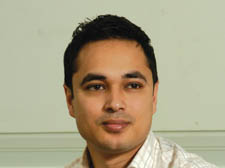|
|
 |
| |

Abdul Hai |
Police watchdog urged to recruit more young and ethnic members
Panel that scrutinises force work ‘is largely made up of white males over 40’
THE community body scrutinising the work of Camden police has been urged to recruit more young members and people from ethnic minority communities.
The Community Police Consultative Group (CCPCG) re-elected a board of members who were all white and all over 40 last week. Eighty per cent of the committee is male.
Abdul Hai, a Labour councillor and youth worker, praised the work of the CCPCG in the aftermath of the London bombings, but said the representation of young black and minority ethnic (BME) members on the group was “very disappointing”.
Cllr Hai said: “The CCPCG was set up following the MacPherson report and the Stephen Lawrence inquiry and I’m afraid the fact that they’re struggling to find people from the BME community – which is a third of the population in Camden – shows there is still a very long way to go. Most importantly, having young people under 30 represented is crucial – young people have been on the frontline of policing, for the wrong reasons, and they need to articulate that. It does good work, but something is going wrong.”
The idea of consultative groups was developed after the 1981 Brixton riots exposed the chasm between police and the people. The groups are meant to “reach out to the marginalised”.
Former board member, and chairman of the Hampstead Safer Neighbourhood Panel, Nigel Steward said: “I was disappointed to see that there was no new blood nominated for the CCPCG board last week. Some young, preferably ethnic, representation is sorely missing and I suspect that this is one of the problems across London.”
Guidelines from the Metropolitan Police Authority on the groups are clearly laid out in a handbook. “They are intended to be representative of the local population, and particularly those groups (such as young people) that interact with the police in disproportionate numbers...It is a must that each CPEG [community and police engagement group] both does everything it can to recruit BME organisations to its membership and appoint BME officers to its executive group.”
At the meetings of the Camden group, held every quarter, the most regular, noticeable absence is young people.
While a significant proportion of the CCPCG’s time is spent talking about youth issues – residents’ complaints about youth anti-social behaviour figure highly – the voices of young people themselves are rarely heard.
Former Camden Youth Council leader Axel Landin, 19, said he had been twice to the CCPCG. He said: “When you have a room dominated by local businessmen, police officers, the great and the good of neighbourhood watches, that can be very off-putting to young people.”
The specifically youth-focused policies of the force have been rarely questioned and barely challenged by the CCPCG in public.
The problems are acknowledged by the CCPCG itself. Its voluntary chairwoman, Janine Griffis, said that the board had employed a part-time outreach worker specifically to target under-represented groups, while she and others on the board frequently brought issues – particularly around stop and search – to the police in private. A review of the membership of the group was launched earlier this year.
Ms Griffis said: “This is something that we discuss frequently at our board meetings, and it has to be said that all groups have problems getting young people or BME groups involved in certain ways. We have to get out there and find them.” |
 |
|
|
 |
Your comments:
|
| |
|
 |
|